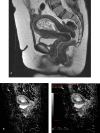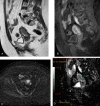Diffusion-Weighted Mri of Postmenopausal Women with Vaginal Bleeding and Endometrial Thickening: Differentiation of Benign and Malignant Lesions
- PMID: 30038987
- PMCID: PMC5854227
- DOI: 10.5334/jbr-btr.1118
Diffusion-Weighted Mri of Postmenopausal Women with Vaginal Bleeding and Endometrial Thickening: Differentiation of Benign and Malignant Lesions
Abstract
Purpose: To investigate the feasibility of diffusion-weighted magnetic resonance imaging (DWI) with apparent diffusion coefficient (ADC) values in differentiating endometrial cancer from benign endometrial lesions in postmenopausal patients with vaginal bleeding and endometrial thickening and to predict the depth of myometrial invasion in endometrial cancer.
Materials and methods: Postmenopausal patients with vaginal bleeding and endometrial thickening were enrolled in this prospective study. T2-weighted, pre- and postcontrast T1-weighted and diffusion-weighted images were obtained. The ADC values of all the patients with endometrial pathologies were recorded. The staging accuracies of DWI and postcontrast T1-weighted images in the assessment of myometrial invasion were evaluated in histopathologically proven endometrial cancer patients.
Results: Fifty-two patients (mean age: 57 ± 10, range: 41-79) were enrolled in the study. Thirty-eight of the lesions were benign (27 as hyperplasia and endometritis; 11 as polyps). Fourteen of the 52 endometrial lesions were pathologically proven as cancers and underwent hysterectomy, and all the specimens were reported as endometrioid adenocarcinomas. The mean ADC value (10-3 mm2/second) of cancer (0.88 ± 0.10) was significantly lower than that of benign lesions (1.78 ± 0.27, p = 0,001). There was no significant difference between ADC values of endometrial tissue in patients with FIGO stage 1A (0.87 ± 0.11, n = 9) and FIGO stage 1B (0.91 ± 0.07, n = 5). The staging accuracy was 92.9 per cent (13/14) for DWI and 85.7 per cent (12/14) for postcontrast T1-weighted images.
Conclusion: ADC values allow benign endometrial lesions to be differentiated from endometrial cancer in postmenopausal patients but do not correlate with the depth of myometrial invasion and histological tumor grading.
Keywords: Diffusion-weighted imaging; Endometrial carcinoma; Endometrial hyperplasia; Endometrial polyp; Magnetic resonance imaging.
Conflict of interest statement
The authors declare that they have no competing interests.
Figures






References
-
- Wang J, Yu T, Bai R, Sun H, Zhao X, Li Y. The value of the apparent diffusion coefficient in differentiating stage IA endometrial carcinoma from normal endometrium and benign diseases of the endometrium: initial study at 3-T magnetic resonance scanner. J Comput Assist Tomogr. 2010;34:332–37. doi: 10.1097/RCT.0b013e3181d0f666. - DOI - PubMed
-
- Goldstein RB, Bree RL, Benson CB, et al. Evaluation of the woman with postmenopausal bleeding: Society of radiologists in ultrasound-sponsored consensus conference statement. J Ultrasound Med. 2001;20:1025–36. - PubMed
LinkOut - more resources
Full Text Sources
Other Literature Sources

